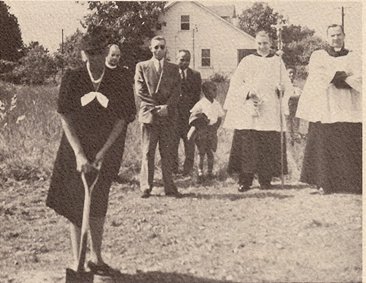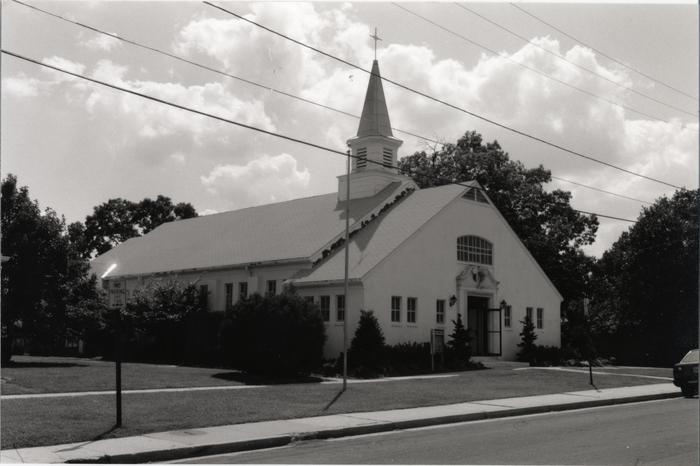November is Black Catholic History Month. Take some time to read about Arlington’s historic Black Catholic church.

Founding member Mrs. Alice Moorman breaking ground for Our Lady Queen of Peace, September 20,1946. Behind her is Clarence Brown. From the OLQP website.
On a warm, green September day in 1946, Mrs. Alice Moorman, wearing her Sunday best, struck a shovel into the ground while her neighbors and priests looked on. She paused and posed for a picture – this was a moment they would want to remember for a long time to come.
Here, in the Nauck neighborhood at S. Edgewood and 19th St., is where they would build their church, Our Lady Queen of Peace (OLQP).
OLQP was born from a shared faith and resistance against racist attitudes that Black Catholics encountered in Arlington. The local Catholic Church at that time, Saint Thomas Moore, was not welcoming to Black parishioners. They were segregated to the balcony of the church and were served communion last.
Saint Mary’s in Alexandria (the oldest Catholic church in Virginia) was more welcoming, but because buses didn’t run on Sunday, it was inaccessible to those without a car. Some traveled to Washington, D.C. to attend the historically Black St. Augustine, but even then, Black Arlingtonians faced discrimination on public transportation.
In 1945, 16 Black Catholics came together and petitioned Bishop Ireton of the Diocese of Richmond to establish a church in Arlington County where they could worship in dignity. They were Joseph Bowman, Clarence and Selena Brown, Alice Butler, Lawrence and Jessie Butler, Irma Carter, Hattie Ellis, Mary Fernanders, Edward Marshall, Grace McGwinn, Edward and Alice Moorman, Constance Spencer, Sophia Terry and Thaddenia West.
Even before they had a church to worship in, the 16 founding members began holding mass in their homes. Father Joe Hackett celebrated their first mass on Pentecost Sunday, May 20, 1945. Two years later, on Pentecost Sunday, June 15, 1947, Bishop Peter Ireton dedicated Our Lady Queen of Peace.

Our Lady Queen of Peace, 2700 S. 19th St. Photograph taken August 25, 1996. From PG 202: The Palmer Collection: Arlington Structures and Places, 1996-2006.
Jackie Smith and her family were among the earliest members of OLQP. In 1952, her mother Lena Alfred converted to Catholicism and joined the church. She became active in numerous groups, including the sodality (a lay devotional society), credit union and choir. In an interview with Jackie, who became an active parishioner herself, she recalled cooking with her mother for fundraiser dinners at OLQP.
SMITH: In 1952, Mama said we were going to become Catholic.
INTERVIEWER: And why did she make that decision?
SMITH: Well, I guess because, she had friends, you know, like Mrs. West or others who were Catholic. I mean, she liked the Catholic religion better. I don’t know all her reasoning, and I never really asked her “Why did you do that?” Maybe one of my siblings know, but I don’t know.
INTERVIEWER: You weren’t invited to make a decision?
SMITH: No, I mean I did what my mom said. We’re going to Our Lady Queen of Peace, and we’re going to become Catholics. And that’s what we did.
INTERVIEWER: And did they join various groups in there? Did your mother join the sodality?
SMITH: My mother joined the sodality. My mother was on the credit union. She was on the credit union’s supervisory committee. My mother was in the choir, you name it. And my mother was very active. I’m sort of like her, my mother was on quite a few committees in the church. Yes.
INTERVIEWER: And did you find that other families were active too?
SMITH: Yes.
INTERVIEWER: So they were part of a really good team, weren’t they?
SMITH: Good team. Yeah. And when we first came up here at Our Lady Queen of Peace, they used to have dinners, fundraisers. In the back of the church, there was a kitchen. And some of my fondest memories was working with my mom, frying chicken or whatever for the fundraiser and making money for the church.
INTERVIEWER: Tell me what they served at that fundraiser.
SMITH: They would have fried chicken and greens and potato salad, desserts, and those kinds of things like that.
INTERVIEWER: Real good Southern cooking.
SMITH: Southern cooking. That’s a great way to put it. And there would be a group of women, Black women. Cause at that time, the church was totally Black.
INTERVIEWER: Totally Black?
SMITH: Black. Yeah. Until the 1960s when the diocese changed the boundaries of the church, to include Columbia Pike and all the other surrounding areas, then it became a little bit more mixed. But at first, it was all Black.
The church officially integrated in the 1960s, but a few white families joined earlier on. Theresa Quinnan Fitzgerald became one of the first non-Black members in the mid-1950s when her parents decided to leave St. Thomas Moore and join OLQP.
Theresa’s early memories of OLQP are defined by the colorful personality of Father David Ray, who joined the church in 1958 and guided it through integration. Under his leadership, OLQP established a large multipurpose Family Activity Center, a daycare center and the Matthew 25 thrift shop to provide free clothing and resources to the community. Fr. Ray was also known for his ministry to LGBTQ Catholics.
INTERVIEWER: That’s the priest who was the great orator?
FITZGERALD: Mhmm [affirmative].
INTERVIEWER: He was very well, very much admired.
FITZGERALD: He’s the one who, people, they would come from Dupont Circle, from as far as Dupont Circle.
INTERVIEWER: From the gay community that he serviced there.
FITZGERALD: But at the time, nobody knew about this community.
INTERVIEWER: Right.
FITZGERALD: It was still hush-hush.
INTERVIEWER: Pretty underground?
FITZGERALD: Pretty underground, yeah, exactly.
INTERVIEWER: Tell me more about Father Ray as a personality.
FITZGERALD: He was a huge personality. He was military man. I think he was a retired army colonel. And he was, he was in this very, very poor, you know, sent to this very, very poor parish, and I think it was quite an adjustment for him, to be in this poor parish. But he was out there in the community, he was a great talker, a great hand-shaker. He would, you know, go to the local drug store, corner store, and get in conversations with people. There was no stopping him, he was just a big personality.
Over the decades, OLQP has continued to grow and expand its ministry. In the 1970s, during a wave of immigration following the fall of Saigon, Vietnamese Catholics began joining the parish. Beginning in the 1980s, OLQP saw an influx of Latino parishioners. Spanish mass is celebrated weekly to this day.
The thriving parish, now home to a diverse community of over 1,500 families from all walks of life, carries forth the legacy of 16 brave Arlingtonians who set out to create a safe and welcoming space to practice their faith.
Sources:
Jackie Smith interview - Charlie Clark Center for Local History Oral History Project
Our History - Our Lady Queen of Peace Catholic Church
Theresa Quinnan Fitzgerald interview - Charlie Clark Center for Local History Oral History Project
Timothy Hickey interview - Charlie Clark Center for Local History Oral History Project
Help Build Arlington's Community History
The Charlie Clark Center for Local History (CCCLH) collects, preserves and shares resources that illustrate Arlington County’s history, diversity and communities. Learn how you can play an active role in documenting Arlington's history by donating physical and/or digital materials for the Center for Local History’s permanent collection.
Do you have a question about this story, or a personal experience to share?
Use this form to send a message to the Charlie Clark Center for Local History.
Center For Local History - Blog Post Message Form
Do you have a question about this story, or a personal experience to share? Use this form to send a message to the Center for Local History.
"*" indicates required fields